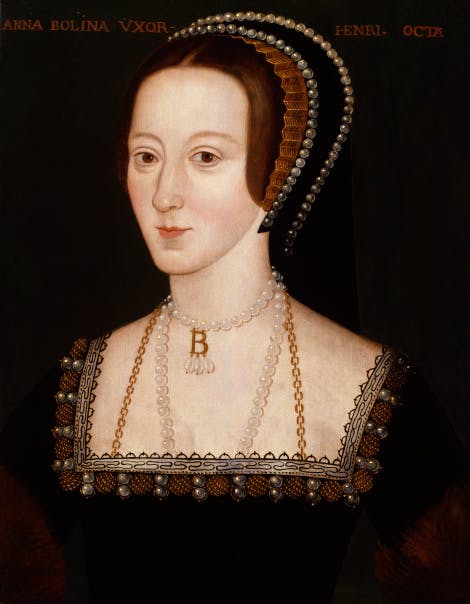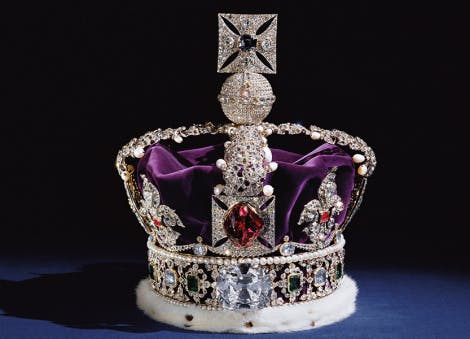Rare Tudor ring thought to have belonged to the Boleyn family goes on display at Hampton Court Palace
On display from 8 February 2023
They are a family synonymous with the Tudor dynasty, favoured courtiers and relatives to one of England’s most famous queens, Anne Boleyn. Now, visitors to Hampton Court Palace will be able to get up close to a piece of jewellery which may well have once belonged to the Boleyn family, when an exceptional gold signet ring goes on display in the magnificent Great Hall this week.
Discovered in a field in Kent near the country home of one of Queen Anne Boleyn’s cousins which she visited with King Henry VIII, the gold signet ring provides a tantalising link to the family. The ring is engraved with a bull’s head and arrayed with sunbeams and stars of white enamel, and is also decorated with icons of the Virgin and Child and St Catherine of Alexandria on its shoulders, making it an unusual combination of both personal and religious jewellery. The ring has been analysed at the British Museum where it was found to be consistent with objects of the early Tudor era, leading historians to suggest that it may have belonged to either Thomas or George Boleyn – Anne Boleyn’s father and brother. The heraldic bull’s head featured on it also appears in the arms of the Boleyn family, including in a version on the seal of a document from Thomas Boleyn dating to that period. It was likely chosen as a visual pun or rebus on the family name, which was often spelled as ‘Bullen’.
The ring is not thought to have belonged to Anne herself, due to the fact she bore her own arms after her marriage to King Henry VIII, with this signet ring also being a typically male item of jewellery which would have been too large for a woman. However, both Thomas and George held the title of Viscount Rochford from 1525 and 1529 successively, meaning that either man would have been entitled to bear the monogram for Rochford. The ring features an initial that could denote the letter R – further strengthening the claim that it has links to the two Boleyn men. Sir Thomas Boleyn (c.1477 – 1539) was one of Henry VIII’s most influential courtiers and was even created Knight of the Garter at the King’s accession in 1509. His son George (c.1504 – 1536) later followed in his footsteps to enter the King’s service, becoming a senior privy chamber servant, master of the King’s buckhounds and also ambassador to France. However, his favour with the King meant nothing when he was later implicated in his sister’s downfall, meeting the same fate as Anne at the Tower of London in 1536.
The ring was discovered not far from Shurland Hall on the Isle of Sheppey in Kent, which was the home of Sir Thomas Cheney (or Cheyne), a relative of the Boleyns as well as Constable of the Kent castles of Rochester and Dover, and reported Treasure via the Portable Antiquities Scheme. The religious symbolism may well also hold the key to the ring’s original owner, with St Catherine being known for her scholarly defence of her faith, and the choice of saint perhaps referring to Henry’s first wife, Katherine of Aragon. There is a possibility the ring may have alternatively belonged to another wealthy Tudor who bore the same badge, although this does not change the fact that is a remarkable piece of surviving jewellery from the era.
This exquisite object has been acquired by Historic Royal Palaces (HRP) – the charity that cares for Hampton Court Palace. It will now be shown to visitors in the Great Hall, which sits at the very heart of the surviving Tudor palace (the apartments built for Queen Anne Boleyn were lost in the 17th century). Home to the last great medieval hammerbeam roof hall in England, work began on the Great Hall began in 1532 to mark the King’s marriage to Anne Boleyn, with motifs relating to the new Queen incorporated into the design.
The ring was acquired under the Treasure Act of 1996, administered by the British Museum on behalf of the Department of Digital, Culture, Media and Sport. HRP is also grateful for the generous financial support from the Arts Council England/V&A Purchase Grant Fund, as well as donations from its own patrons.
Sebastian Edwards, Deputy Chief Curator at Historic Royal Palaces, said “We are thrilled to acquire this rare Tudor jewel for our collection and to be able to show it a Hampton Court for the first time this February, thanks to the Portable Antiquities Scheme and our very generous donors. This is a remarkable survival, which prompts fascinating questions about who it may have once belonged to and how it might have been used at the Tudor court. We may never know for certain if it was worn at Hampton Court by a member the Boleyn family, but it is entirely appropriate that such a wonderful Tudor discovery can now be enjoyed by our many visitors who come to admire King Henry VIII and Queen Anne Boleyn’s incomparable Great Hall, which bore witness to many significant events of their reign.”
The gold Tudor signet ring will be on display in the Great Hall at Hampton Court Palace from 8 February 2023 and is included in palace admission.
Notes to Editors
For further information and images please contact Sophie Lemagnen in the Historic Royal Palaces Press Office via press@hrp.org.uk / 020 3166 6166
Tickets: Adult £26.10 / Concession £20.90 / Child £13.00. Free for Historic Royal Palaces members.
Purchased by Historic Royal Palaces with generous support from the Arts Council England/V&A Purchase Grant Fund, the Meakins Family and John Harding, under the terms of the Treasure Act 1996.
Historic Royal Palaces is a team of people who love and look after six of the most wonderful palaces in the world. We create space for spirits to stir and be stirred. We want everyone to feel welcome and accepted. We tell stories about the monarchs you know and the lives you don’t. We let people explore and we set minds racing. We are a charity and your support gives the palaces a future, for everyone.
Registered charity number 1068852. For more information visit www.hrp.org.uk
The Arts Council England/V&A Purchase Grant Fund
- The Arts Council England/V&A Purchase Grant Fund is a government fund that helps regional museums, record offices and specialist libraries in England and Wales to acquire objects relating to the arts, literature and history.
- It was established at the Victoria and Albert Museum (V&A) in 1881 and continues to be part of its nationwide work.
- The annual grants budget, currently £725,000, is provided by Arts Council England National Lottery Funding
- Each year, the Purchase Grant Fund considers some 150 applications and awards grants to around 100 organisations, enabling acquisitions of over £3 million to go ahead.
- Visit the website: www.vam.ac.uk/purchasegrantfund
Browse more history and stories

Anne Boleyn
How did Anne Boleyn become queen and why did Henry VIII execute her?

The Crown Jewels
The history of the Crown Jewels, including the Imperial State Crown - a priceless collection used to crown the kings and queens of England.

Life at the Tudor court
In the Tudor period, a monarch’s home was centre of the nation
